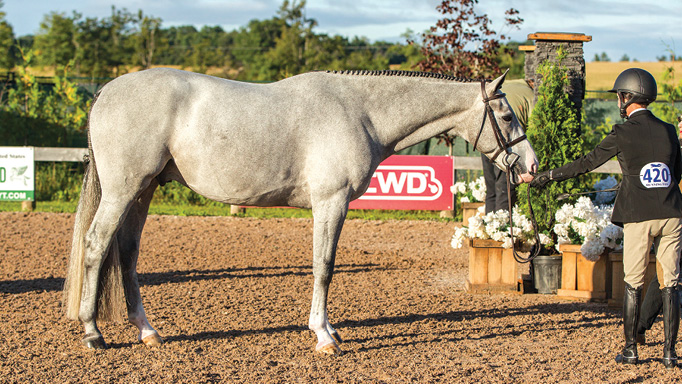If you show conformation or model hunters, the time will come when you have to “strip for conformation” and stand your horse up for inspection by the judge. In order to look for obvious conformation flaws, blemishes, etc., the judge will want to see the horse presented at its best stance.
Randy Roy of King, ON, has been judging and showing horses for decades, and knows a thing or two about proper presentation in the show ring. “They need to stand square in front; absolutely square, with one hind leg slightly ahead of the other.” While it doesn’t matter which hind leg is straight down and which is offset, Roy warns, “Make sure they don’t have their hind leg cocked; they should be standing with weight evenly on all four legs.”
Make sure the horse is not “camped out” in an unnaturally long stance, either. “You don’t want them stretched out; you have to line them up so they’re ready to walk off or trot off, or come forward with their hind end underneath them and not splayed out.”
Positioning the head and neck is equally important, aiming for neither too low nor too high. “You don’t want them drooping down to the ground, you want them stretched out, showing a good length of neck,” says Roy. “You want to give a little crest to it. If they’re high-headed, you need to encourage them to bring their head down and out to you.”
If the horse insists on leaning or moving forward, he suggests, “It’s smart to carry a crop just to keep them away from you a little bit. I’ll use the end of the stick to hold them away from me.” This prevents the horse from stepping ahead or leaning so far forward it tips its weight onto its forehand.
And finally, you want them alert ‒ but not spooky or fiddly ‒ with their ears up, using whatever attention-getter works. Roy likes to grab a twig off a tree or brush jump and twirl it around in his fingers. “I don’t want to use anything in the food department, because they’ll lean on me and get all over me.” A little squeakie toy or piece of crinkly cellophane will also do the trick. “But no lighters!” he admonishes.
A last piece of advice: “As a handler, especially with the kids, I always say ‘find your place and let the judge walk around you.’ Don’t keep trying to dodge the judge. The more you keep moving, the more you get in the way. Also, don’t stand right in front where they can’t see between the front legs; get yourself off to the side a little bit so they can look for splints and so on. Find your place, hold your ground, and do not move.” The judge will let you know if they need you to briefly step aside for the inspection.

